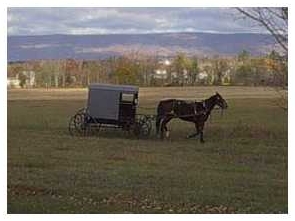
A picture from our kitchen window!
Amish Links

Amish Links
No, I am not Amish. If I were, I wouldn't be on the internet! Because the Amish try to keep apart from the rest of the world, there isn't much decent information on the net. In fact, there are more "joke" sites about the Amish than even tourist sites! To remedy that a bit, I've listed a few decent links (below) and provided a brief introduction.
In the late 1500's, along with the more familiar reformation movements
such as the Lutherans and the Calvinists, there was a more "radical"
movement known as the Anabaptists. As the name suggests, they believed
that baptism should come in early adulthood, when one is capable of
making a meaningful confession of faith. In addition, they
believed in complete separation of the church from affairs of the
state, and refused to serve in the military. These beliefs led to
considerable persecution.
The Mennonites are a branch of the Anabaptists which began with the
teachings of Menno Simons in Holland. Persecution led them to
migrate to Switzerland and other areas. There are millions of
Mennonites today, spread throughout the world.
In the late 1600's, a group of believers in Alsace, led by Jacob Ammon,
split from the mainstream of Mennonites on the basis of a disagreement
concerning the practice of avoidance, better known as shunning:
If someone persists in deviating from Biblical rules, his community
must avoid all contact with him. This practice remains a part of
Amish life today.
Persecution led the Amish to migrate to Pennsylvania in the early
1700's, where William Penn promoted a spirit of religious
tolerance. Later, others migrated to other parts of North
America. Today there are some 100,000 Amish in the US and Canada.
The Amish are actually quite extreme in their religious beliefs.
For example, they take the Bible literally and do not permit marriage
outside their religious community. There is an oral tradition
called the Ordnung which establishes general practice, but there is no
central organization, so each community develops its own details.
The day-to-day language of the Amish is called Pennsylvania Dutch (from
Deutsch, meaning German, not
Netherlandish). Sunday worship circulates through the homes of
the
community, rather than taking place in a church.
Perhaps the most distinctive belief of the Amish is reflected in the
Bible
verse "Be ye not conformed to the world," meaning that one should
separate
oneself in one's appearance and practices from the mainstream of
society,
conforming instead as well as possible to Biblical tradition. So,
for
example, the Amish do not collect social security, unemployment
insurance,
or welfare. Instead, each Amish community makes sure that
everyone's
needs are taken care of. In addition, education is controlled by
the
Amish community, in the form of small schools. Education does not
usually
extend beyond the eighth grade.
From the point of view of mainstream society, the most impressive
aspect of Amish life is the way in which they appear to be stuck in a
time-warp: They make an effort to live in the fashion of the
1600's of their forefathers. They do not usually use automobiles,
nor do they use electricity or phones in their homes. Instead,
they use horse-drawn buggies, mules or horses to pull farm equipment,
oil lamps to light their homes, and so on.
Amish clothing is also distinctive: Women wear dresses, usually
of a single bold color, a white apron, and black bonnets. The
dresses use
no buttons or fasteners other than straight pins. Men wear
plainly cut
black suits and flat-brimmed hats of black felt or straw. Men
grow their
beards but shave their mustaches. They prefer that tourists not
take
their pictures, however.
They are not always consistent in their practices: While use of
cars is prohibited among the adults, many of their children will drive
until they commit to the Amish lifestyle, and adults have no problem
with having other people drive them places. While electicity is
taboo in the house, generators can be found in the barns, and
telephones are sometimes kept in a shed at the edge of the
property. And so on.
But overall, the Amish are a pleasant, hard-working people. Their
life-style is often an inspiration to those of us enveloped by the
intense
and often inhumane culture of the modern world. Although strictly
speaking
religious extemists, they do not proselytize and treat others in a
polite
and tolerant fashion. The same cannot always be said of people in
the
mainstream.
The Amish And "The Plain People" -- A Pennsylvania tourism
site -- but with nice descriptions and pictures, including a detailed
description of Amish wedding traditions.
http://www.800padutch.com/amish.shtml
Welcome to the Amish Heartland Online! -- An Ohio tourism
site
-- but very informative and attractive.
http://www.amish-heartland.com/
Origins of the Old Order Amish -- The origins of the Old
Order
Amish, an essay provided by the National Committee for Amish Religious
Freedom.
http://www.holycrosslivonia.org/amish/origin.htm
The Amish: Beliefs, practices, conflicts -- A look at
the history and beliefs of the Amish, by the Society for Religious
Tolerance.
http://www.religioustolerance.org/amish.htm
The Amish -- Bea Sheftel's lovely essays on Amish life.
Very informative.
http://www.amishfamilies.com/
Amish Country News -- Another Pennsylvania tourist
site.
Gives plenty of information about events in the area, some quite
authentic.
http://www.amishnews.com/
Amish Online -- The people from Discovery Online take a look
at the Amish. A really cute page, it follows an amish family over
several days. Nice for kids, especially.
http://www.discovery.com/area/exploration/amish/amish1.html
The Amish Farm and House -- All the details of daily Amish
life, with many pictures. It's a Lancaster County tourist
attraction, but very nice.
http://www.amishfarmandhouse.com/
Das alt Schulhaus an der Krick, by Heinrich Harbaugh -- A
nice
sample of Pennsylvania German on Dr. Paul S. Boyer's website.
http://alpha.fdu.edu/~boyer/Schulhaus_an_der_Krick.html
Pennsylvania German -- The Mennonite Historical Society of
Canada has an online encyclopedia, with many interesting articles,
including this one on the Pennsylvania German dialect. There is
much else besides. (Mennonites are the somewhat more liberal
relatives of the Amish.)
http://www.mhsc.ca/encyclopedia/contents/D5351ME.html